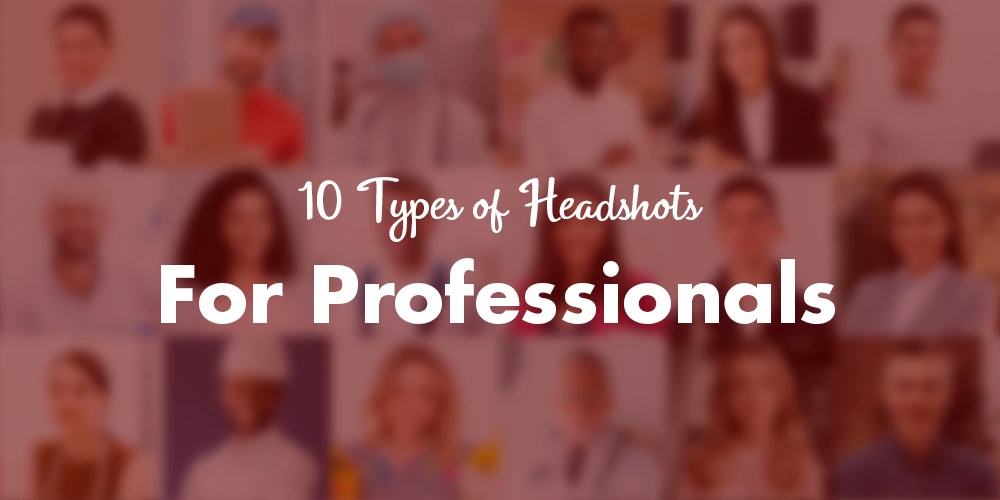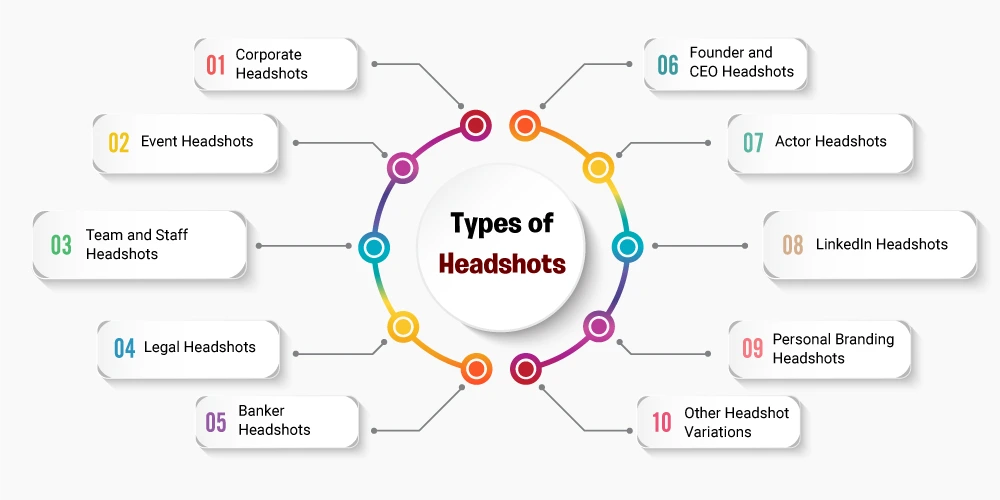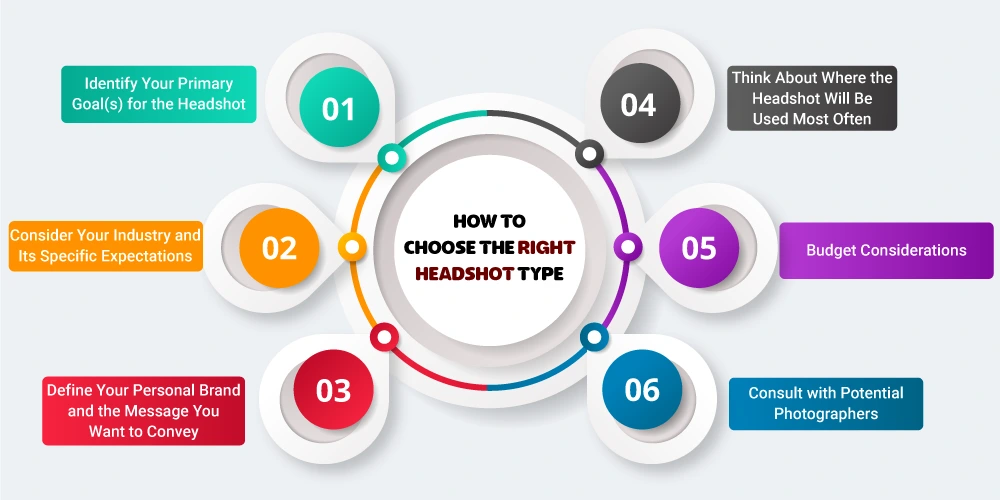Types of Headshots: Finding the Perfect Shot for Your Career & Brand
Are you still relying on a casual selfie or a cropped photo from a trip as your professional headshot? You’re not alone — and it might hurt your image more than you realize.
Research from Princeton University shows it takes just 1/10th of a second to form a first impression based on a photo.
In today’s digital world, your headshot often speaks before you do. Many professionals feel confused about what type of headshot they need. The good news? A well-planned headshot can open doors, build trust, and show your authentic self. This guide will help you find your perfect headshot style and prepare for success.

Why a Great Headshot Matters?
Your headshot is often people’s first impression of you in the digital world. A strong, professional image matters because it can shape how others perceive you in the blink of an eye. A high-quality headshot builds trust and credibility on platforms like LinkedIn, company websites, and casting profiles. It helps you stand out in a crowded professional landscape and aligns your image with your personal or professional brand. Your headshot is more than just a picture; it’s a key personal branding tool that communicates your personality and values.
- First impression matters: It shapes how you’re perceived.
- Build trust: A professional headshot builds credibility across platforms.
- Stand out: Helps you differentiate yourself in a competitive world.
What Defines a Headshot?
A headshot is a focused photograph of a person, typically showing the head and shoulders or upper body. Unlike portraits or lifestyle shots, headshots are meant to capture a clean, professional image that highlights the subject’s face.
Key elements of a good headshot include:
- The eyes should engage the viewer, as they are the most potent element in the photo.
- A natural, approachable expression helps convey your personality.
- Soft, flattering lighting defines your features and minimizes shadows.
- A clean, complementary background ensures the focus stays on you.
- The photo should be crisp and clear, ensuring every detail stands out.
This is what sets a headshot apart from other photos, such as lifestyle images or portraits, which often have a more relaxed or creative style.
Key Characteristics of an Effective Headshot
A great headshot should reflect professionalism and authenticity. Here are the key elements:
- Expression: Keep it natural—whether you’re aiming for confidence (corporate), approachability (real estate), or versatility (acting), your expression should align with the context.
- Connection with the Camera: Engage with the camera through your eyes to create a direct connection with the viewer.
- Lighting: Use soft, flattering lighting to highlight your features without harsh shadows.
- Background: Keep it simple and clean, ensuring it doesn’t distract from your face.
- Wardrobe: Wear professional, non-distracting attire that suits the context.
- Retouching: Keep retouching minimal to maintain a natural look.
- Technical Quality: Ensure sharp focus, good exposure, and appropriate depth of field for a polished image.
Types of Headshots
Headshots vary significantly based on the industry, role, and personal brand. Here’s an overview of common headshot types, their purpose, and typical styles, along with tips on avoiding common mistakes.

1. Corporate Headshots
Corporate headshots are professional photos used in business settings to represent individuals within corporate environments.
Purpose: These headshots are used for LinkedIn profiles, company websites, business cards, email signatures, and press releases. They project a polished, professional image.
Typical Style: Corporate headshots generally feature formal or business casual attire with a neutral or simple background, often a studio or clean office setting. The expression is confident yet approachable.
Common Mistakes:
- Casual or inappropriate clothing (e.g., t-shirts or overly trendy fashion).
- Backgrounds that are cluttered or distracting.
- Poor lighting that casts shadows or makes the subject look washed out.
- Stiff poses or awkward body language that feel unnatural.
Tip: Choose a simple background and professional attire, ensuring your expression is engaging yet confident. A slightly relaxed pose helps avoid looking too rigid.
2. Event Headshots
Event headshots captured during conferences, trade shows, or corporate events, these headshots give professionals an opportunity to update their image on the spot. They’re convenient for networking, internal profiles, or event directories.
Typical Style: Usually shot in a portable studio or against branded backdrops at the event. The style is polished but approachable, and often business casual.
Common Mistakes:
- Poor lighting due to mobile setups.
- Limited time per person, leading to rushed, unflattering expressions.
- Distracting event backgrounds if no professional setup is provided.
Tip: If you’re attending an event headshots, wear simple, clean attire and prepare as if it’s a full session—you never know how widely your image will be used later.
3. Team and Staff Headshots
Team & Staff headshots are used on company websites or internal directories to represent staff members in a unified and professional way.
Typical Style: Usually shot with a consistent background, lighting, and pose to maintain brand cohesiveness across an organization.
Common Mistakes:
- Inconsistent styling or lighting between team members.
- Overly rigid poses that lack personality.
- Failing to update headshots regularly, especially after major team changes.
Tip: Work with a team and staff photographer who can create uniformity while still capturing each team member’s individuality.
4. Legal Headshots
Legal headshots are used by attorneys and legal professionals on law firm websites, bar association profiles, and legal publications to convey authority and professionalism.
Typical Style: Formal, conservative attire—often dark suits—with neutral or law office-style backgrounds. The tone is confident, poised, and trustworthy.
Common Mistakes:
- Expressions that appear too stern or cold.
- Overly stylized or modern backgrounds that feel off-brand for legal professionals.
- Casual clothing or posture that lacks formality.
Tip: Legal headshots should inspire trust and competence. Stick to classic styles and conservative colors.
5. Banker Headshots
Bankers’ headshots are used for financial professionals across banks, investment firms, and financial advisory services to project credibility and competence.
Typical Style: Sharp business attire—usually suits and ties for men, and professional dresses or blazers for women—with clean, corporate backdrops.
Common Mistakes:
- Too casual or trendy fashion choices that don’t align with the industry.
- Busy backgrounds that diminish professionalism.
- Forced smiles or stiff expressions.
Tip: Opt for a banker headshot must be a confident yet calm expression. Let your wardrobe reflect trust and financial authority.
6. Founder and CEO Headshots
Founders and CEOs use headshots for press releases, investor decks, keynote appearances, and company branding to embody leadership and authenticity.
Typical Style: Varies depending on the company culture—can range from traditional executive headshots to more modern, personal branding styles.
Common Mistakes:
Using outdated or overly corporate images that don’t reflect their current brand.
- Over-editing that removes authenticity.
- Stiff or disconnected expressions that lack warmth.
Tip: This headshot should strike a balance between approachability and leadership presence. Showcase personality while maintaining professionalism.
7. Actor Headshots
An actor headshot is a specialized photo used by actors for casting calls and performances. Actor headshots are used for submitting to casting agencies, theatrical programs, and IMDb profiles. These images must convey emotional range and versatility to show the actor’s suitability for different roles.
Typical Style: Actor headshots often feature clean, solid backgrounds (typically grey or blue), with an emphasis on the face and eyes. Actors may need both commercial (smiling) and theatrical (serious or intense) looks. The headshot should reflect the actor’s current appearance, including hair, weight, and age.
Common Mistakes:
- Using outdated photos that don’t match your current look.
- Distracting clothing or backgrounds that pull attention away from your face.
- Forced or overly posed expressions that feel unnatural.
- “Model-like” poses that do not reflect the authentic personality or character of the actor.
Tip: Your headshot should feel like “you on your best day.” Make sure it accurately represents your current look, and update it regularly to reflect any changes.
8. LinkedIn Headshots
A LinkedIn headshot is a professional photo used for online professional networking and job-searching.
Purpose: The headshot is used across professional platforms like LinkedIn, where it serves as the first impression for potential employers, business partners, or collaborators.
Typical Style: LinkedIn headshots tend to fall somewhere between corporate formality and casual approachability. They’re often business casual, with a tighter crop than corporate headshots. It’s essential to be approachable, as LinkedIn is a platform for networking.
Common Mistakes:
- Using low-quality images or blurry photos.
- Wearing inappropriate attire (e.g., overly casual or too formal).
- Using selfies or photos that include multiple people.
- Poor lighting or backgrounds that distract from the subject.
Tip: Make sure your LinkedIn headshot aligns with the professional image you want to portray. Keep the background simple and avoid anything that distracts from your face.
9. Personal Branding Headshots
Personal branding headshots represent an individual’s personal style and unique identity for personal or business use.
Purpose: These headshots are widely used for personal websites, social media profiles (Instagram, Facebook, Twitter), and promotional materials such as author bios, speaker profiles, or online courses.
Typical Style: This type of headshot can vary greatly depending on the person’s brand. It might include a more relaxed pose or even a creative background that aligns with the person’s personal or professional identity. A personal branding headshot often captures an individual’s personality and style.
Common Mistakes:
- Using an image that doesn’t match your personal or professional brand (e.g., a professional headshot for a creative brand).
- Poor image quality that diminishes your brand’s credibility.
- A lack of personality or failing to connect with the audience visually.
Tip: Ensure your headshot aligns with your brand’s vibe, whether it’s formal or creative. Make sure the image is high-quality and accurately reflects who you are.
10. Other Headshot Variations
it’s important to remember that some industries have specific requirements for the style of headshot they prefer:
- Modeling Headshots
These photos are used by models to showcase their look for agencies or clients. They typically emphasize a wide range of emotions and styles.
Common Mistakes: Avoid overly posed or artificial expressions that don’t reflect the natural range of emotions.
- Real Estate Agent Headshots
Purpose: Real estate agent headshots help agents connect with potential clients and build trust. They should be professional yet friendly.
Common Mistakes: Avoid using casual or dated photos that don’t match the professional image of a real estate agent.
- Dating Profile Headshots
Purpose: These photos are used for online dating platforms to give potential matches an accurate representation of you.
Common Mistakes: Avoid overly edited photos or anything too posed. Authenticity and approachability are key.
Did You Know? Research shows that people judge your photo within milliseconds—first impressions based on headshots can shape someone’s entire perception of you before you’ve even spoken a word. |
How to Choose the Right Headshot Type
Choosing the right headshot can feel overwhelming, especially with the various types available. The key is to align your headshot with your professional goals, industry expectations, and personal brand. Here’s a key points to help you strengthen the decision-making process:

- Identify Your Primary Goal(s) for the Headshot
Start by asking yourself why you need a headshot. Are you building a personal brand, seeking a corporate job, or auditioning for roles? Your goals will guide your decision. For example, an actor’s headshot will differ significantly from one used for LinkedIn or a personal brand. - Consider Your Industry and Its Specific Expectations
Different industries have different expectations for headshots. Corporate sectors might require formal attire and a polished look, while creative fields like entertainment allow more flexibility. Research industry-specific guidelines or consult professionals in your field to understand the norms. - Define Your Personal Brand and the Message You Want to Convey
A headshot is a visual representation of your personal or professional brand. Think about what you want to communicate—confidence, approachability, expertise, or creativity. For instance, if you’re an entrepreneur, a personal branding headshot that showcases personality and authenticity is key. - Think About Where the Headshot Will Be Used Most Often
Where will your headshot appear the most? If it’s for LinkedIn or a corporate website, aim for a professional, approachable look. For social media or a personal website, you might want something a bit more relaxed or creative. - Budget Considerations
Budget will play a role in the type of headshot you can afford. Professional photographers can provide high-quality images that enhance your professional presence, but if you’re on a tighter budget, consider opting for a more affordable photographer or even a well-executed DIY session with proper lighting. - Consult with Potential Photographers
Choosing the right photographer is a crucial part of the process. Photographers are experts in creating images that reflect your personality and brand. Don’t hesitate to reach out and ask for advice—they can help guide you on the best type of headshot based on your needs and the industry you’re targeting.
Comparison Table of Headshot Types
Here’s a quick visual guide to help you compare the different types of headshots based on their primary use, style, and key focus:
| Headshot Type | Primary Use/Industry | Typical Style/Vibe | Key Focus |
|---|---|---|---|
| Corporate | Company websites, LinkedIn, Business Cards | Formal to Business Casual; Clean, simple background | Professionalism, Confidence |
| Actor | Casting Profiles, Theatrical Programs | Versatile, Clean background; Studio or Natural Light | Expression, Emotional Range, Versatility |
| Professional Networking Profiles | Business Casual to Approachable; Often tighter crop | Approachability, Professionalism, Clarity | |
| Personal Branding | Websites, Social Media, Author Bios, Speaker Kits | Varies greatly; Reflects personality; Studio or Environmental | Personality, Authenticity, Brand Alignment |
| Modeling | Modeling Portfolios, Agencies | Clean, minimalist; Focus on bone structure/features | Features, Versatility for different looks |
| Real Estate Agent | Business Cards, Websites, Billboards | Approachable, Trustworthy; Often smiling, confident | Trust, Approachability, Local Expertise |
Preparing for Your Headshot Session
Preparing for a headshot session can feel a little daunting, but with the right steps, you can ensure a successful and stress-free shoot. Here’s how to make the most of your session:
Reducing Anxiety and Ensuring Success
Feeling anxious or awkward is common, but good preparation can ease these nerves. To make sure you’re relaxed and ready:
- Get enough rest the night before: A good night’s sleep ensures you look and feel fresh.
- Practice your expressions in the mirror: It helps you feel more natural in front of the camera.
- Communicate your goals: Let the photographer know exactly what you want from the shoot, whether it’s for LinkedIn, your portfolio, or personal branding. Sharing examples of headshots you like (or dislike) helps too.
Wardrobe Planning
What you wear is critical in getting the right look. Keep these tips in mind:
- Bring multiple options: Having a few choices allows you to pick the best fit.
- Focus on solid colors and classic styles: These are timeless and less distracting.
- Avoid busy patterns and logos: These can pull attention away from your face.
- Layering options: Jackets or cardigans can add versatility.
- Ensure clothes fit well: Make sure everything is wrinkle-free and comfortable.
- Keep accessories simple: A few subtle touches are fine, but avoid overdoing it.
- Product recommendation: Look up wardrobe style guides for professional photos to ensure you’re on the right track.
Hair and Makeup
To look your best:
- Consider a professional hair and makeup artist: If possible, choose a professional who understands camera-ready looks.
- Aim for a natural, polished appearance: Keep your look similar to how you’d typically wear your hair and makeup.
- Bring touch-up supplies: Have a small kit for quick fixes during the session.
- Hair should be clean and styled: It’s important to look like yourself.
- Product recommendation: Check out hair and makeup tutorials for photos to ensure you’re photo-ready.
Communicating with Your Photographer
Clear communication with your photographer ensures the session goes smoothly:
- Discuss your specific goals and industry requirements: Let them know how you intend to use the photos.
- Be open about what you want to convey: If you need to look approachable or authoritative, make that clear.
- Trust the photographer’s expertise: They’ll help you with posing and lighting. Don’t hesitate to ask for direction and guidance.
- “Behind the Lens” Tip: Photographers often suggest trusting their expertise for the best results.
During the Shoot
When it’s time for the session:
- Relax and breathe: It’s normal to feel a bit tense, but calm down and enjoy the process.
- Focus on connecting with the camera lens: Eye contact is key to a powerful image.
- Experiment with expressions and poses: Don’t be afraid to try different things to capture the best shot.
- Ask for breaks if you need them: It’s okay to take a moment if needed.
After the Shoot
Once the shoot is done:
- Review proofs carefully: Make sure the shots reflect your authentic self and meet your goals.
- Discuss retouching preferences: If you want any adjustments, make sure they’re natural enhancements.
Clarify licensing and usage rights: Understand how you can use the images and ask about the licensing.
Enhance Your Professional Image with the Right Headshot
A great headshot is a valuable investment in both your career and personal brand. It plays a crucial role in making a strong first impression, showcasing professionalism, trust, and confidence. Whether you’re updating your LinkedIn profile, looking for job opportunities, or growing your personal brand, the right headshot helps you stand out. Proper preparation and selecting the right photographer are essential to capturing an image that truly reflects your goals. At DNB Productions, we specialize in crafting personalized, high-quality headshots that highlight your unique professional presence. Ready to make an impact? Book your session today!
DNB Productions
Douglas N. Burns
we specialize in bringing your business to life through exceptional commercial and business photography.
